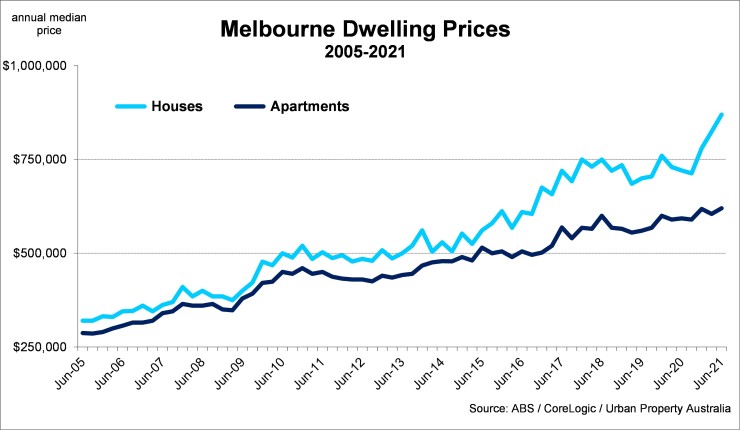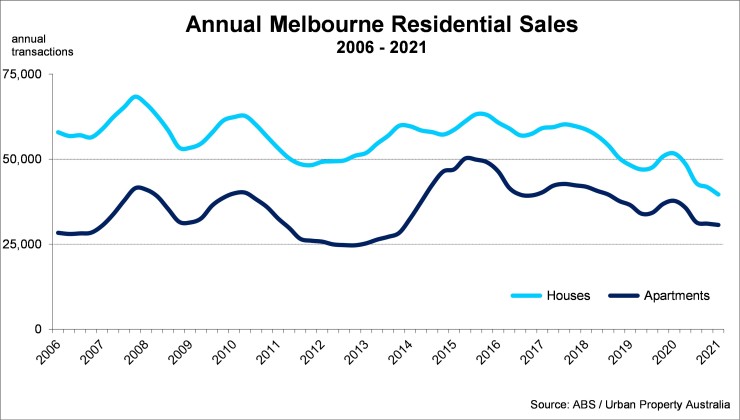Q2 2021 – Melbourne Residential Market
August 2nd 2021 | , Urban Property Australia
- Melbourne’s house and apartment prices have once again set a new all-time high as at June 2021 with house prices growing at their fastest annual growth rate since 2010;
- Vacancy rate for Melbourne residential property appears to have peaked, however remains well above its 10-year average;
- Victorian housing owner occupier finance has surged in recent months to almost double the 10-year average with first home buyers at all-time highs.
Residential Market Summary
Despite the headwinds of various lockdowns and COVID-19 restrictions, Melbourne’s house and apartment prices have once again set a new all-time high as at June 2021. Melbourne house prices grew by 21% over the year to June 2021, its fastest annual growth rate since 2010. Victorian housing owner occupier finance has surged in recent months to almost double the 10-year average with first home buyers at all-time highs.
Prices
Melbourne’s house and apartment prices have once again set a new all-time high as at June 2021. Melbourne house prices grew by 21% over the year to June 2021, its fastest annual growth rate since 2010. Despite the headwinds of various lockdowns and COVID-19 restrictions, Melbourne apartment prices have also reached record high levels in June 2021, having increased by 4.6% over to year to $620,000. Whilst buyer sentiment has been boosted by 10-year low unemployment rates, record low interest rates and elevated savings through COVID-restrictions, according to CoreLogic, total advertised listings remain around 20% average levels which has created some urgency amongst purchasers. The strong buyer demand conditions is also evidenced in the auction clearance rates, with the Victorian auction clearance rates surpassing 95% despite the number of auctions double those on offer last year.

Supply
According to the ABS, there are currently 64,000 dwellings under construction across Victoria having trended down since 2018. Although the current dwelling supply pipeline of Victoria is below the peak of March 2018, the number of dwellings currently under construction remain 9% above the 10-year average. The closure of Australia’s international borders is also expected to reduce demand for inner city rental housing given the likely lack of international students in the short term. A shift in preferences towards detached houses has also been weighing on demand for inner city apartments. However, near-term risks of oversupply – and therefore sharp price declines – are mitigated by the considerably smaller volume of higher-density inner city apartments due for completion in 2021 relative to previous years. In the 12 months to May 2021, a total of 65,300 dwellings were approved in Victoria, relatively in line with the five-year average. Reflecting the slowdown of the development of apartment developments, approvals for houses now account for 70% of all new dwellings approved, compared to 52% as at May 2018.
Demand
In response to a range of factors including record low interest rates and recent economic conditions that have consistently beaten forecasts, Australians are feeling optimistic and confident in making high commitment decisions related to the property market. In response, total Victorian housing finance commitments reached 20-year highs in May 2021, underpinned by owner occupiers. Owner occupier finance has surged in recent months to almost double the 10-year average and 73% levels seen 12 months ago. First home buyers remain active in the market with current levels at all-time highs and 144% higher than the 10-year average. In terms of the composition of loans, the proportion of loans to first home buyers sits at 33%, well above its 10-year average but below its recent peak of 40% in January 2021. Investor finance has also picked up in recent months with levels rising to six-year highs, albeit their share of total loans remains below their 10-year average.

Vacancy
According to the REIV, as at June 2021, the vacancy rate for Melbourne residential property has eased to 6.1%, seemingly having peaked at 6.5% in April 2021, however remains well above its 10-year average of 2.8%. Although vacancy rates of all precincts (with the exception of the Outer region) remain elevated, vacancy rates have trended down since peaking earlier this year. As at June 2021, the residential vacancy rate increased to 7.6% in the Inner (0-4km) precinct and 6.6% in the Middle precinct and 2.3% in the Outer precinct. Looking ahead, Urban Property Australia projects that the vacancy rate for the metropolitan Melbourne area will remain elevated for the short term, particularly in the Inner precincts given Victoria’s population growth will be muted for the medium term, constrained by the closure of Australia’s international borders affecting the international student market.
Rents
Emulating the vacancy trends, according to the REIV, metropolitan residential rents across most of the precincts are showing signs of stabilising having fallen in through 2020. Interestingly, rents for houses and apartments in the Outer suburbs rose over the year to June 2021. Over the year to June 2021, the weekly median rent for houses in metropolitan Melbourne fell to $470 per week, down from $473 per week a year earlier. In contrast, the weekly median rent for units has fallen to $400 per week, down from $420 per week a year earlier. While rents have declined over the year, there are emerging signs that the rental market is stabilising with rents relatively stable since November 2020. Looking forward, Urban Property expects that residential rents will gradually increase through 2021 as the broader economy continues to improve following the shock of the pandemic, however increases will be constrained with Australia’s population growth likely to be modest for the medium term.
Copyright © 2021 by Urban Property Australia All rights reserved. No part of this publication may be reproduced in any form, by microfilm, xerography, electronically or otherwise, or incorporated into any information retrieval system, without the written permission of the copyright owner.



